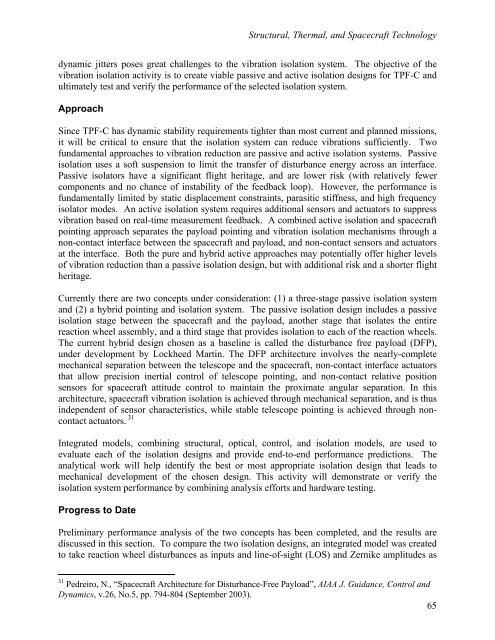TPF-C Technology Plan - Exoplanet Exploration Program - NASA
TPF-C Technology Plan - Exoplanet Exploration Program - NASA
TPF-C Technology Plan - Exoplanet Exploration Program - NASA
Create successful ePaper yourself
Turn your PDF publications into a flip-book with our unique Google optimized e-Paper software.
Structural, Thermal, and Spacecraft <strong>Technology</strong><br />
dynamic jitters poses great challenges to the vibration isolation system. The objective of the<br />
vibration isolation activity is to create viable passive and active isolation designs for <strong>TPF</strong>-C and<br />
ultimately test and verify the performance of the selected isolation system.<br />
Approach<br />
Since <strong>TPF</strong>-C has dynamic stability requirements tighter than most current and planned missions,<br />
it will be critical to ensure that the isolation system can reduce vibrations sufficiently. Two<br />
fundamental approaches to vibration reduction are passive and active isolation systems. Passive<br />
isolation uses a soft suspension to limit the transfer of disturbance energy across an interface.<br />
Passive isolators have a significant flight heritage, and are lower risk (with relatively fewer<br />
components and no chance of instability of the feedback loop). However, the performance is<br />
fundamentally limited by static displacement constraints, parasitic stiffness, and high frequency<br />
isolator modes. An active isolation system requires additional sensors and actuators to suppress<br />
vibration based on real-time measurement feedback. A combined active isolation and spacecraft<br />
pointing approach separates the payload pointing and vibration isolation mechanisms through a<br />
non-contact interface between the spacecraft and payload, and non-contact sensors and actuators<br />
at the interface. Both the pure and hybrid active approaches may potentially offer higher levels<br />
of vibration reduction than a passive isolation design, but with additional risk and a shorter flight<br />
heritage.<br />
Currently there are two concepts under consideration: (1) a three-stage passive isolation system<br />
and (2) a hybrid pointing and isolation system. The passive isolation design includes a passive<br />
isolation stage between the spacecraft and the payload, another stage that isolates the entire<br />
reaction wheel assembly, and a third stage that provides isolation to each of the reaction wheels.<br />
The current hybrid design chosen as a baseline is called the disturbance free payload (DFP),<br />
under development by Lockheed Martin. The DFP architecture involves the nearly-complete<br />
mechanical separation between the telescope and the spacecraft, non-contact interface actuators<br />
that allow precision inertial control of telescope pointing, and non-contact relative position<br />
sensors for spacecraft attitude control to maintain the proximate angular separation. In this<br />
architecture, spacecraft vibration isolation is achieved through mechanical separation, and is thus<br />
independent of sensor characteristics, while stable telescope pointing is achieved through noncontact<br />
actuators. 31<br />
Integrated models, combining structural, optical, control, and isolation models, are used to<br />
evaluate each of the isolation designs and provide end-to-end performance predictions. The<br />
analytical work will help identify the best or most appropriate isolation design that leads to<br />
mechanical development of the chosen design. This activity will demonstrate or verify the<br />
isolation system performance by combining analysis efforts and hardware testing.<br />
Progress to Date<br />
Preliminary performance analysis of the two concepts has been completed, and the results are<br />
discussed in this section. To compare the two isolation designs, an integrated model was created<br />
to take reaction wheel disturbances as inputs and line-of-sight (LOS) and Zernike amplitudes as<br />
31 Pedreiro, N., “Spacecraft Architecture for Disturbance-Free Payload”, AIAA J. Guidance, Control and<br />
Dynamics, v.26, No.5, pp. 794-804 (September 2003).<br />
65
















